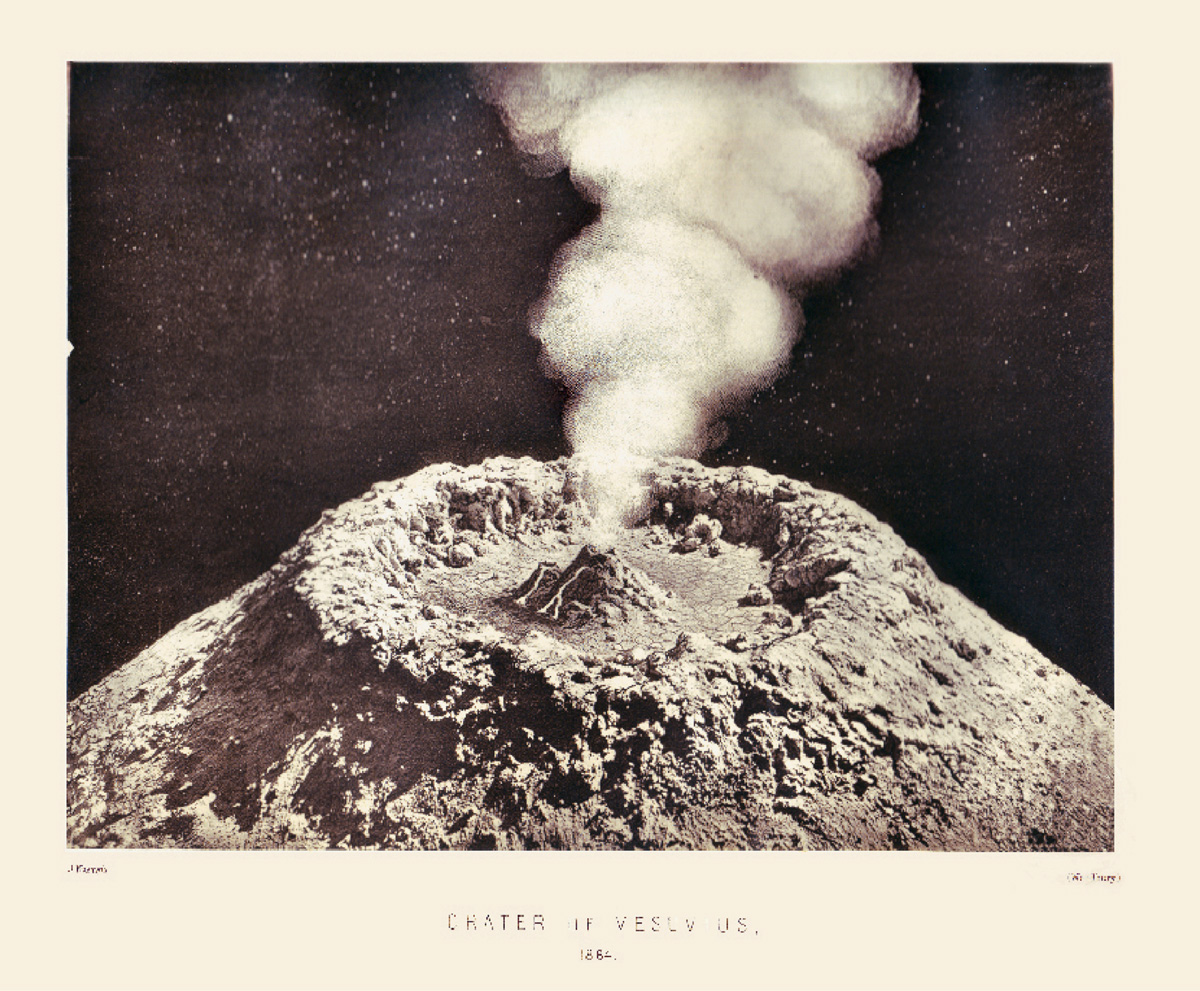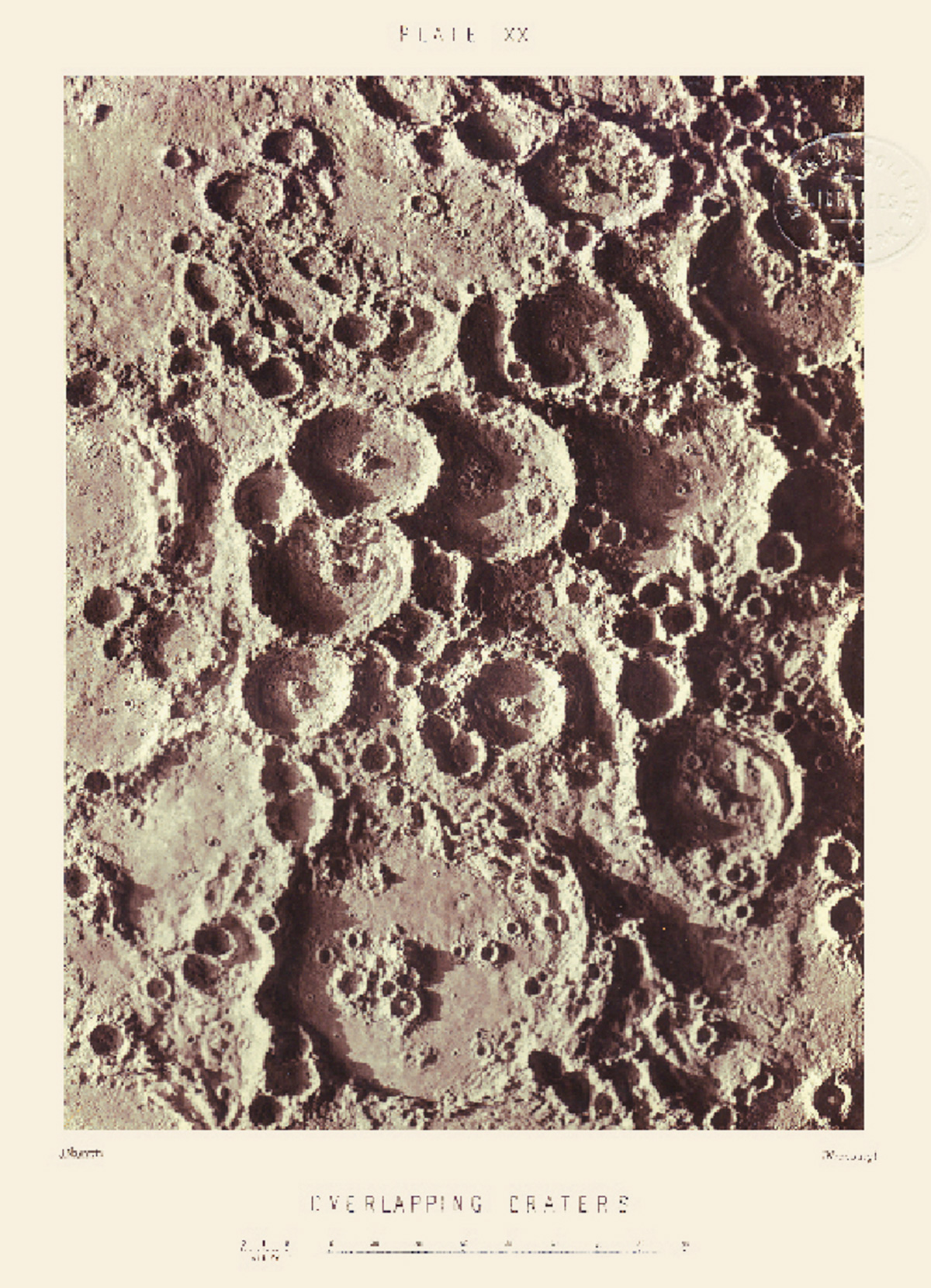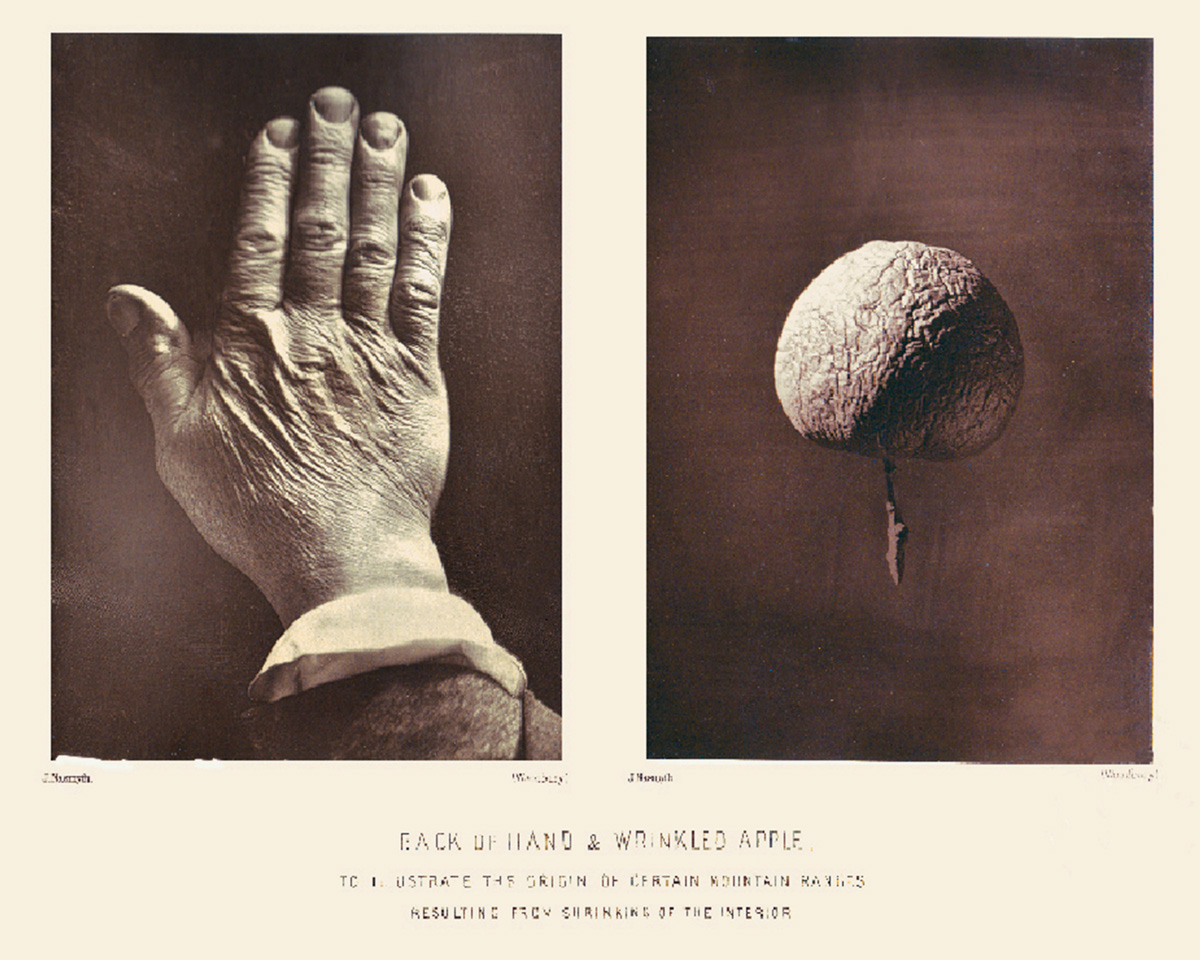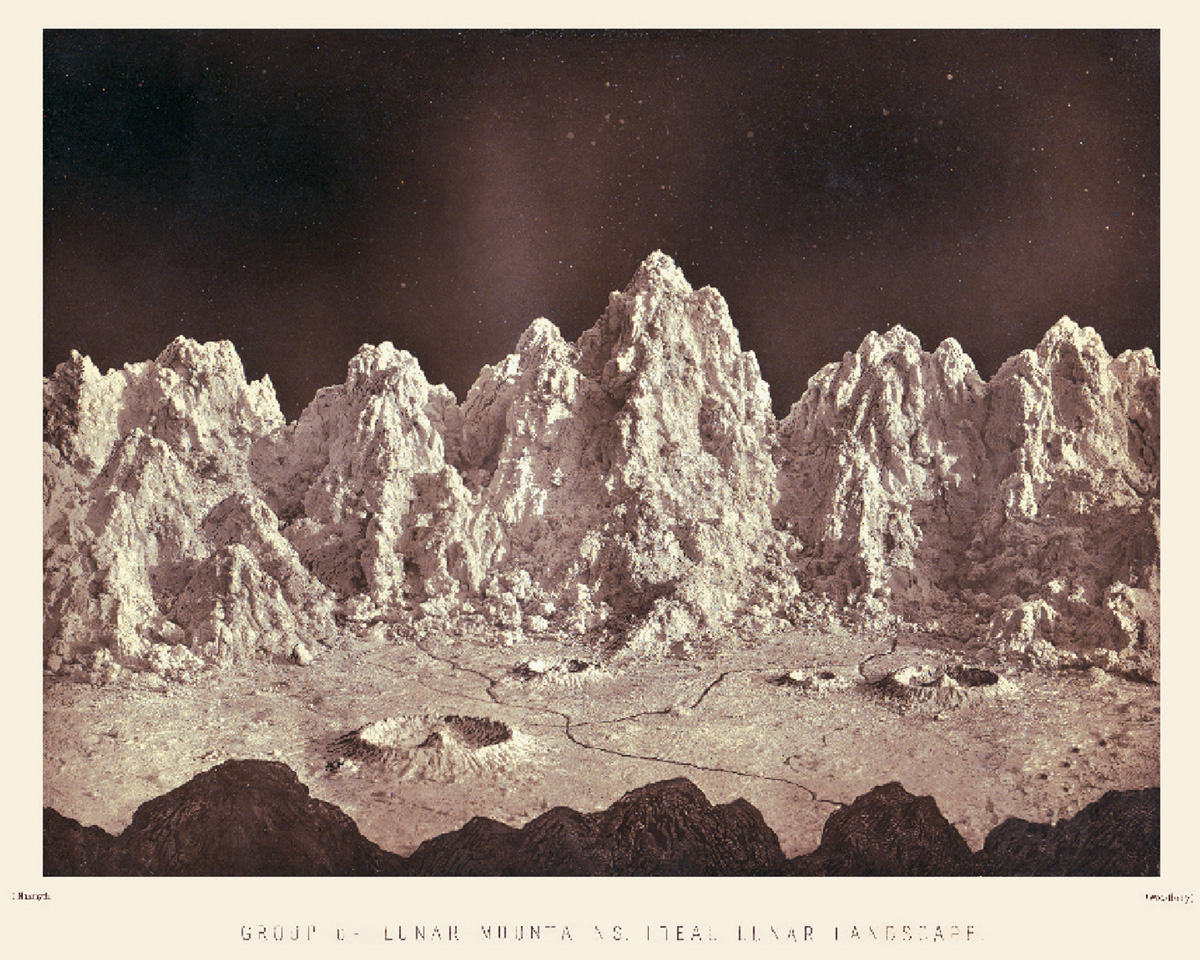Lunar Park
James Nasmyth and the mountains of the moon
Christopher Turner
The curious photographs that illustrate the Victorian industrialist James Nasmyth’s book, The Moon: Considered as a Planet, a World, and a Satellite (1874), depict the pockmarked lunar surface, with its craters, craggy mountains, and volcanoes, in startling detail. One image shows a chalky landscape of overlapping craters and their ramparts, the largest of which is named for Ptolemy, in such detail that one can almost feel the crumbly pumice. Another photo shows a close-up of Copernicus (in the 1650s, selenographers—cartographers of the moon—began christening lunar craters after astronomers), an impressive coliseum almost sixty miles wide with terraced sides that rise up to 12,500 feet.
At first glance these photographs appear to be taken at magnifications near to those of the US Ranger 7 space probe, which beamed back the first high-resolution pictures when it orbited the moon in July 1964, before crashing into the northern rim of the Mare Nubium, the “Sea of Clouds.” How could an amateur astronomer working in northern England almost one hundred years before the space age, with only a homemade telescope and primitive camera, have achieved such impressive verisimilitude?
Nasmyth was the son of the celebrated Scottish landscape painter and portraitist, Alexander Nasmyth. In 1839, the year photography was invented, he patented the steam hammer, a pile-driving device that was powerful enough to forge the huge plates of steel required for large-scale industrialization. It earned him a fortune and enabled him to retire seventeen years later at the relatively young age of forty-eight, and devote his last thirty years to his hobbies: astronomy and photography. He had been an addict of the night sky since 1842, when he began his lunar observations. The midnight apparition that a neighbor believed to be a ghost carrying a coffin was, in fact, an insomniac Nasmyth, dressed in his nightgown, lugging his telescope around his estate near Manchester so as to get the clearest view of the heavens.
Nasmyth later used his metallurgical and engineering skills to build an even more powerful stargazer, with a twenty-inch speculum mirror that he cast and ground himself, which enabled him to see at magnifications of 300x. An engraving exists of Nasmyth sitting at the controls of this sizeable instrument, staring 238,857 miles into space. His design, which employed a tertiary mirror so that one could look through the telescope from the side, rather than straight down the barrel, is still in use. Like an enormous cannon, it was mounted on a circular rail so that, by turning two handles, Nasmyth could more easily track the moon’s movement across the sky.

In Sidereus Nuncius (The Starry Messenger, 1610), Galileo had declared that the moon was “just like the surface of the earth itself, which is varied everywhere by lofty mountains and deep valleys.” Before Galileo trained his telescope on it, Aristotelean cosmology maintained that the moon was smooth, a huge mirror which reflected the earth; it is appropriate that the names Galileo gave to its mountain ranges echo, correspondingly, terrestrial landmarks: the Caucasus Mountains, the Apennines, the Carpathian Mountains, the Alps. Nasmyth speculated that because of the absence of an atmosphere on the moon, there would be no diffusion of light to soften or give a sense of perspective to these mountain chains, which would make them seem much more impressive than their earthly counterparts—the landscape would seem to overwhelm and engulf the viewer, looming over them all at once in equally harsh contrasts of light and shade.
“The scenery which they would present,” he concluded, referring to the three thousand peaks he counted in the lunar Apennines, “could we get any other than the ‘bird’s eye’ view to which we are confined, must be imposing in the extreme, far exceeding in sublime grandeur anything that the Alps or the Himalayas offer.”
As Nasmyth gazed in wonder at the cosmos, he made detailed sketches of the moon in black and white chalk on large sheets of gray-toned paper. Like his father, he was an accomplished draftsman; drawing, he wrote in his Autobiography, was as familiar to him as language. The resulting six-foot-tall “Picture Map of the Moon” was shown at the Crystal Palace in the Great Exhibition of 1851, where it was exhibited alongside his steam hammer—he won a gold medal for both contributions. However, it was his lunar map that brought Nasmyth to the attention of Queen Victoria and Prince Albert, who were fascinated by his graphic studies and invited Nasmyth to present them in a private audience when they visited Manchester later that year.
From his drawings, Nasmyth made plaster models of the moon’s most interesting features and landmarks. The Science Museum in London still owns some examples of these sculptures, each one about twenty inches square, along with Nasmyth’s original telescope; they show how Nasmyth fleshed out his romantic fantasy of the moon in stucco, rendering in three dimensions the flat, bird’s eye view available to him. Nasmyth then photographed these miniature craters and peaks of his own invention from above, lit from a low-angle, as if seen through a much more powerful telescope than was then available. The results were far more striking and immediate than the indistinct shots of the distant planet taken through telescopes by contemporary pioneers of celestial photography such as Warren de la Rue, Henry Draper, and Lewis Rutherford.
The images in The Moon are therefore at three removes from what Nasmyth actually perceived with his homemade instrument. Though his pictures were not intended as a hoax, in his drawings, models, and photographs, Nasmyth moved increasingly in the direction of fantasy. He imagined a total perspective from the partial view available to him, which might be interpreted as more of an artistic than a scientific enterprise. However, as he proudly noted, his photographs were praised by distinguished astronomers, such as Sir John Herschel, for their trustworthy appearance as scientific illustrations: “These copies,” Nasmyth boasted, “were hailed by the highest authorities in this special department of astronomical research as the best examples of the moon’s surface which had yet been produced.”
• • •
In 1842, on a Grand Tour of Europe, Nasmyth visited Naples and climbed Vesuvius. Having spent his life working with pots of molten iron, Nasmyth wanted to throw a souvenir from his Bridgewater Foundry into the volcano as a tribute to Vulcan, the god of fire and the symbol of his trade. A small eruption was in progress and clouds of sulphurous smoke belched from the crater, which spat and dribbled white-hot lava down its sides:

Once or twice, indeed, I was half choked by the swirls of sulphurous and muriatic acid vapour that environed me before I could reach the upper edge. I sat down in a nook, though it was a very hot one, and made a sketch or two of the appearance of the crater. But I feel that it is quite beyond my power either by pen or pencil, to convey an idea of the weird unearthly aspect which the funnel-shaped crater of Vesuvius presented at that time.
Nasmyth spent five hours drawing at the crater’s edge, before making his offering to the gods. While sitting in the ash, he had the epiphany that encouraged him to begin his astronomical studies: might Vesuvius’s “weird unearthly aspect” provide a clue to lunar topography?
Nasmyth’s volcanic explanation of the moon’s bumpy features was not new, but had been popular since the eighteenth century. In 1787, the astronomer William Herschel, who suspected the moon might be inhabited, claimed to have witnessed “an actual eruption of fire, or luminous matter” through his forty-foot telescope. In Outlines of Astronomy (1849), his son, John Herschel, compared the craters and mountains of the moon to the landscape around Vesuvius and the Campi Flegrei; he was a friend of Nasmyth and most likely first heard this observation from him. Though The Moon was not published until twenty-five years later, it was in this book that Nasmyth gave the volcanic theory its most comprehensive elucidation.
The eighteenth-century naturalist Georges Buffon believed that the earth and the moon were formed 75,000 years ago when a comet ploughed into the sun, slicing off two balls of fire. Nasmyth thought that both planets were formed millennia earlier, bonded by the heat generated by the friction of huge boulders as they crashed around in the solar nebula. Nasmyth supposed that when the moon cooled and hardened, which would have happened far more quickly than it did on Earth, a planet three times the size, the crust would have been too large to fit its shrunken core. Its surface would have buckled and blistered to create a series of dramatic mountain ranges and volcanic flues, the lively commotion of which has since been frozen in time.
To illustrate the effects of age on a surface of evaporating mass, Nasmyth juxtaposed, in a manner that would have appealed to the surrealists, a photograph of his own wrinkled hand with one depicting a shriveled apple dangling on an invisible wire. This poetic contrast, designed “to illustrate the origin of certain mountain ranges by shrinkage of the globe,” highlights the importance of tactility in Nasmyth’s argument, which sought to persuade through a series of arresting, concrete images. “The truth is that the eyes and the fingers—the bare fingers,” Nasmyth wrote in his Autobiography, “are the two principal inlets to sound practical instruction. … No book knowledge can avail for that purpose. The nature and properties of the materials must come in through the finger ends.” Nasmyth’s indexical signature can also be seen in the photo of his plaster model of Vesuvius, where he has smudged the negative with his fingerprint to create an effect of billowing smoke.

This image, shot against a black backdrop depicting twinkling stars in interplanetary space, is one of the first illustrations in The Moon. It is made to look deliberately celestial, designed to emphasize the volcano’s similarity to the lunar craters reproduced elsewhere in the book. Based on his close-range observations of Vesuvius, Nasmyth thought that the central domes he saw in the middle of lunar craters were the heads of extinct volcanoes. He believed that the mountainous rings that encircled these volcanoes were formed from the cooled excreta thrown up by successive blasts. Nasmyth ventured that due to the reduced gravity on the moon, volcanic debris would be carried much larger distances than would be possible on Earth, creating craters that could be a hundred miles wide—Vesuvius, he wrote, would be “the merest molehill in comparison.” Nasmyth thought that the most mountainous regions of the moon were formed by later, less volatile eruptions, which oozed slowly at a time when the moon’s volcanic forces were dying down to create gravity-defying towers of lava up to twenty thousand feet high.
The year before Nasmyth’s book appeared, the British astronomer Richard A. Proctor published The Moon: Her Motions, Aspect, Scenery, and Physical Condition, presenting his hypothesis that lunar craters were the holes left by collisions with meteorites. Nasmyth’s version of lunar history was more widely accepted at the time (partly because his illustrations were so much more convincing), and continued to be popular until the Apollo landing, but Proctor’s theory has since eclipsed it. Scientists now believe, following Proctor, that the odd cones in the middle of lunar craters are not the mouths of dormant volcanoes, but were created by the shockwaves of molten plasma that radiated from the impact sites of meteorites or asteroids millennia ago, before rebounding off the crater walls to congeal in a central column.
The highest mountains of the moon are thought to have been formed by the ejecta from the largest of these collisions, rather than through tectonic or volcanic activity. These thousand kilometer-wide holes filled with flows of molten basalt that hardened to create the relatively smooth oceans of darkness (maria) visible from Earth with the naked eye. The few extinct volcanoes to be found on the moon are only a few hundred feet high. Because gravity on the moon is a sixth of what it is on Earth, the lava that once flowed from them traveled long distances rather than heaping up at the eruption source, as Nasmyth imagined. Indeed, the moon’s mountains are much smaller than he—or Galileo—estimated. The highest summit is Mons Huygens in the lunar Appenines, which geologists have measured at 15,500 feet, just over half the size of Mount Everest.
• • •
With his models of “Ideal Lunar Landscapes,” photographed as if from the moon’s surface, Nasmyth crosses over completely into the realm of science fiction. In an illustration of one such fantastical vista, a phosphorescent mountain chain rises majestically from a plain that is scarred with dry canals and pimply craters. Nasmyth encourages the reader to accompany him on an imaginary trip to the moon by conjuring the sublime prospect of the planet’s “dreary, desolate grandeur,” as if it stretched out before him:

From our high standpoint, and looking backwards to the sunny side of our cosmorama, we glance over a vast region of the wildest volcanic desolation. Craters from five miles diameter downwards crowd together in countless numbers, so that the surface, as far as the eye can reach, looks veritably frothed over with them. Near the base of the rampart on which we stand, extensive mountain chains run north and to south, casting long shadows towards us; and away to southward run several chasms a mile wide and of appalling blackness and depth … Nearer still, beneath us, crag rises on crag and precipice upon precipice, mingled with craters and yawning pits, towering pinnacles of rock and piles of scoria and volcanic débris. But we behold no sign of existing or vestige of past organic life.
Even though Nasmyth has been discredited for his facts, his portrait of the moon—pictured as an enormous, vertically exaggerated volcanic ruin, a sort of inverted grotto—defined how it was imagined for decades in the popular imagination. Jules Verne’s Around the Moon (1870), his sequel to From the Earth to the Moon published five years earlier, includes lengthy descriptions of the “English savant” Nasmyth’s ideas of what the planet might look like and how it was formed (Nasmyth published the first of his lunar photographs in 1852). The landscapes in Georges Méliès’s Voyage to the Moon (1902)—the first ever science fiction film, loosely based on Verne’s novel—also owe much to Nasmyth’s photographs, which were popularized in magic lantern shows all around the world, as do the sets for George Pal’s later sci-fi classic, Destination Moon (1950).
Nasmyth believed the moon to be uninhabited, too airless and with such savage extremes of temperature as to make it impossible to sustain any life. He described the lunar landscape as “a fearful dream of desolation and lifelessness—not a dream of death, for that implies evidence of preexisting life, but a vision of a world upon which the light of life has never dawned.” However, even though he thought he was not indulging in flights of fancy, but evoking things as they actually were, the self-described “thoughtful telescopist” spent most of his imaginary life there. It is therefore a fitting memorial that a forty-eight-mile-wide crater on the moon is named for Nasmyth. It adjoins the larger crater Phocylides, and forms the heel of what, if the light is right, looks like an enormous footprint.
Christopher Turner is an editor of Cabinet. His book, Adventures in the Orgasmatron: How the Sexual Revolution Came To America, is due to be published by Farrar, Straus and Giroux next year.